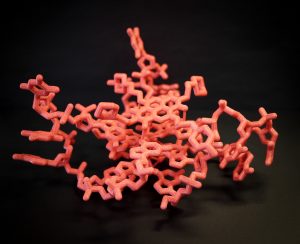
TUSCALOOSA, Ala. — The first 3D print of a G-quadruplex DNA sequence and its molecular structure was recently created at The University of Alabama in the UA 3D Printing Lab, allowing researchers a potentially valuable new tool in the fight against cancer.
Dr. Vincent F. Scalfani, the science and engineering librarian for UA Libraries, collaborated with Drs. Stephan A. Ohnmacht and Stephen Neidle, professor, both researchers at the School of Pharmacy at University College London in the UK, to convert laboratory X-ray crystallography data of a G-quadruplex molecule and the drug targeting it into a 3D digital model suitable for 3D printing.
The process showed just what the 3D Lab is capable of doing, Scalfani said.
“Preparing the G-qaudruplex DNA sequence for 3D printing was a challenge and certainly pushed the limits of what we thought was possible in the UA 3D Lab,” he said. “The structure is extremely intricate, containing multiple areas of stacked functional groups (the quadruplex) that are all surrounded by a common outer loop (the DNA backbone).The 3D printed G-quadruplex is stunning; you can see all of the symmetry, facets and angles within the molecule.”
The 3D printed model of the G-quadruplex DNA will be used to help students and researchers visualize the molecule’s structure, and the model is already being used in pre-clinical studies for pancreatic cancer research.
Both Ohnmacht and Neidle say the power in 3D printing DNA sequences like these is that researchers can literally touch, hold and better understand the biological target they’re aiming for. Before this, researchers had to rely on two-dimensional images.
“Having a live model is invaluable; visualizing distances of bonds, electrostatic interactions and angles is easy and allows for further optimization of these anti-cancer molecules,” Ohnmacht said. “The printed 3D model is actually a real molecular structure that has been designed, synthesized and then crystallized in the London labs.”
The unusual makeup of this DNA sequence required more than two dimensions for research.
“G- quadruplex DNA is unusual as it is four-stranded, not two stranded like ‘normal’ double helical DNA we know,” Ohnmacht said.
The lab is managed by UA’s College of Engineering.
Contact
Bobby Mathews, UA media relations, bwmathews1@ua.edu, 205/348-4956
Source
Dr. Vincent Scalfani, 205/348-5806